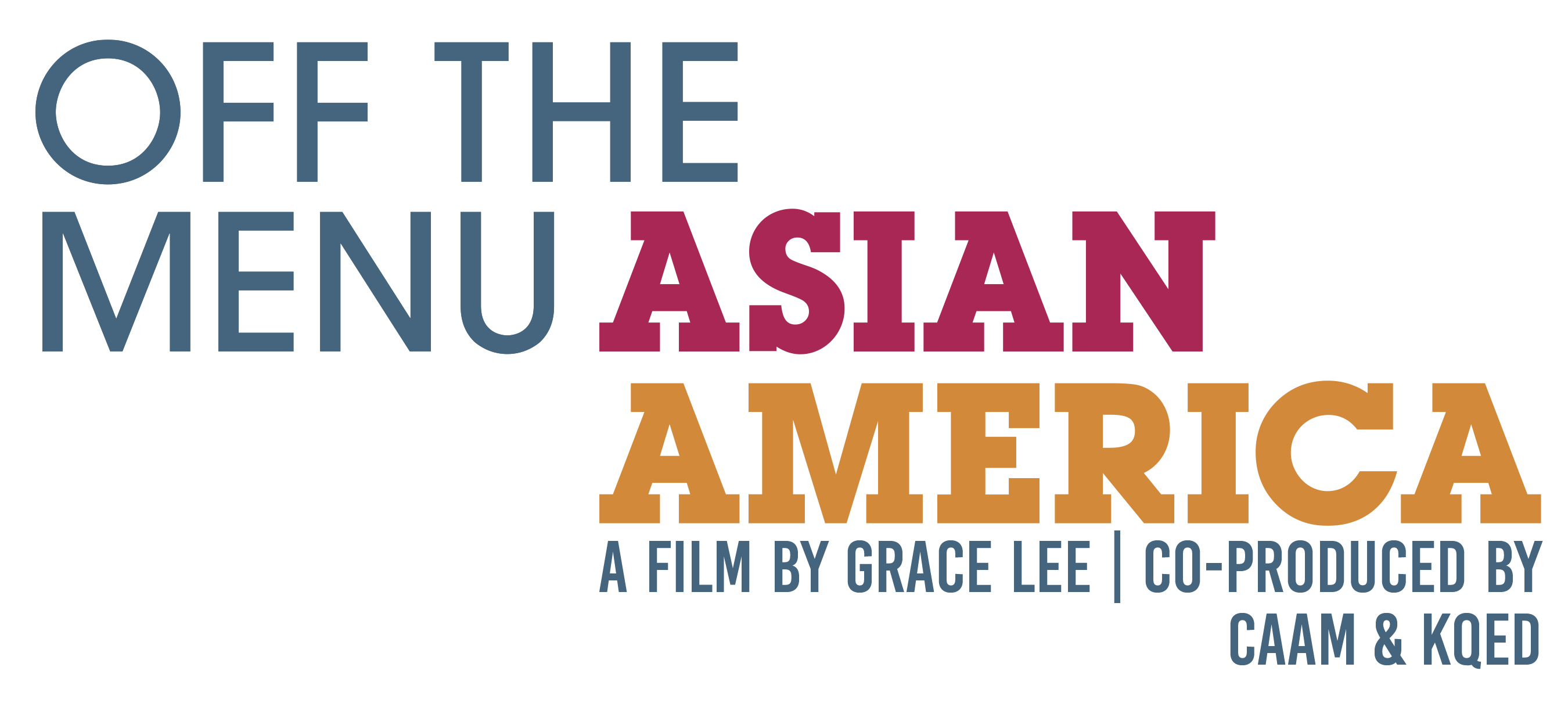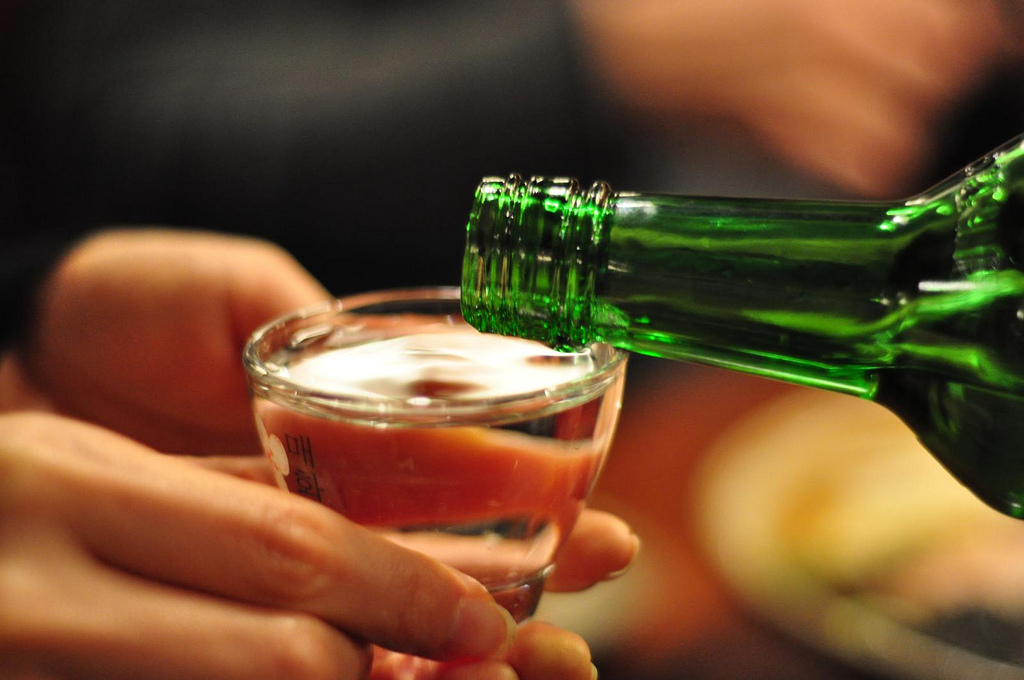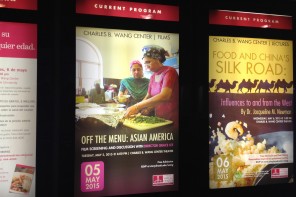Our living room wasn’t very big. It was just spacious enough for a 16-inch analog television and a couch, but in that small space, my father also kept a pair of wooden display cases to house some of his most prized possessions: a collection of imported spirits. Even as he maintained an after-work ritual of drinking inexpensive soju on a nightly basis, he saved those bottles behind the glass for very special occasions, such as holiday gatherings or when guests visited our home.
When my father offered me a sip of his whisky for the first time when I was 10, I felt like it was a rite of passage, as if he were ushering me into manhood. Years later, when I was a high school student and my father was visiting me in L.A. (by that time, he was living and working in Korea), I remember him inviting me to do shots of soju with him after dinner. By that point, I think he assumed that I regularly drank with my friends, even though I was just a teenager.
My early exposure to drinking alcohol is probably familiar to many Korean Americans, who, starting at a young age, often witness how much alcohol is valued, celebrated and considered a key part of socializing and enjoyment with friends and family—or even bonding with one’s dad. For an ethnic community known to stigmatize issues ranging from mental health to cancer, there seems to be a remarkably casual attitude and permissiveness toward exposing young people to this culture of drinking, even excessive drinking.
Throughout his childhood, Sam Joo, a second-generation Korean American who grew up in the San Fernando Valley suburbs of Los Angeles, remembers attending family parties where “there was always a lot of drinking going on,” even though there were children ranging from ages 9 to 11 present. The kids weren’t drinking the liquor, but still, Joo said, “You observe this, and you [as a child] equate that as normal, acceptable behavior.”
Unfortunately, Joo is well aware of the impact this kind of permissive, often encouraging, attitude toward alcohol consumption can have on young people, its harmful effects lasting well beyond their adolescent years. A former residential counselor and prevention specialist at the Asian American Drug Abuse Program (AADAP), he now oversees efforts to stem underage drinking at the Koreatown Youth and Community Center (KYCC), where he serves as the director of Children and Family Services. At the Los Angeles-based nonprofit, he and his colleagues are trying to send a far different message about alcohol consumption than what many Korean Americans may have learned in their youth: this celebrated culture of drinking isn’t “normal, acceptable behavior,” and neither is underage drinking.
“Alcohol is almost a gateway,” said Joo. “Even though drug addicts are addicted to cocaine and heroin, consuming alcohol from an earlier age is a very big part of their addictions.”
During his days working at AADAP, which provides treatment and rehabilitation for individuals struggling with substance abuse, Joo recalled meeting an 18-year-old Korean American client who was addicted to cocaine and crack. “He began ditching classes in junior high, and he would go over to his friend’s house [to drink],” described Joo. “He told me that it all started with drinking beer. Then he moved on to hard liquor, and it eventually led to drug use. Later on, he even had a brand new car, but he ended up selling it for $500 for drugs.”
With real-life examples like these, it’s no wonder the Centers for Disease Control and Prevention identifies underage drinking as a major public health problem. More so than tobacco and illicit drugs, alcohol is the most commonly used and abused drug among youth in the United States. Studies show that people between the ages of 12 to 20 drink 11 percent of all alcohol consumed in the United States, but that 90 percent of this alcohol is consumed in the form of binge drinking, according to the CDC.
A 2013 Youth Risk Behavior Survey, based on statistics collected by the CDC, state and local agencies, found that 35 percent of high school students drank alcohol in the past 30 days, 21 percent binge drank (five or more drinks in one sitting), 22 percent rode with a driver who had been drinking alcohol, and 10 percent drove after drinking. Again, the effects can be long-lasting, as with the case Joo mentioned. Youth who start drinking before age 15 are five times more likely to develop alcohol dependence or abuse later in life than those who begin drinking at or after age 21, says the CDC. It is well-documented that underage drinking also increases the risk of physical and sexual assault, and is also associated with overall risky sexual behavior, academic failure and smoking.
In addition, because there are so many physical and developmental changes occurring during adolescence, underage drinking can lead to brain shrinkage, stagnant formation of connections between nerve cells and even a prominent loss of existing connections in the brain, according to researcher Linda Patia Spear, who specializes in alcohol’s effects on adolescents at Binghamton University.
The consequences can also be deadly. Every year, an estimated 5,000 people under the age of 21 die from alcohol-related car crashes, homicides, suicides, alcohol poisoning and other injuries, including falls, burns and drowning, according to the National Institute on Alcohol Abuse and Alcoholism.
Yet, despite all of these dangers, Korean American community advocates say that, unfortunately, parents, who should be the messengers and disciplinarians on this issue, are often part of the problem.
“I have families come in for counseling services, and if a situation involves the child drinking alcohol, a lot of the parents didn’t seem as upset, compared to times when the situation involved their kids doing poorly at school,” said Joo.
“I think the perception of smoking has slightly changed [in the Korean American community]. I think there’s a recognition that ‘I don’t want my kids to smoke,’” he added. “But I don’t think drinking has caught up to that yet. I think that it’s still much more acceptable.”

Edith Bedolla, who counsels mostly Korean and Latino parents and teens about underage drinking at KYCC, said she’s encountered many parents who didn’t even know the legal age for drinking in the U.S. is 21. “Parents often think, ‘Well, where I come from, whether it’s Korea or Mexico, the legal age for drinking is 18, so here, I let my child drink because they’re under my supervision,’” said Bedolla.
One of her roles is to teach youth skills to better communicate with their parents, so they can talk about issues like pressures to drink with friends. But she said it’s difficult when the parents don’t find underage drinking a problem—or tend to drink quite a bit themselves.
“So we give them information about alcohol, we teach them how to communicate with their parents, and we model the behavior so that they’re comfortable talking to them,” Bedolla explained. “[But] if their parents drink, it’s going to stop them from approaching them. It’s confusing to them. They’re not sure what to do.”
While it’s almost common knowledge that a number of Korean American adults—not unlike their counterparts in South Korea—have a problem with drinking excessive amounts of alcohol (the binge drinking rate for Korean Americans is 25.9 percent, while it’s only 16.2 percent for the general U.S. population, according to the Substance Abuse and Mental Health and Services Administrations, or SAMHSA), various studies also indicate that an alarmingly high number of Korean American youth are drinking before their legal age.
In a recent survey of 1,043 college students under age 21, conducted by AADAP, nearly a quarter of Asian Americans said that they had considered themselves “drunk” more than three times in the past month, compared with only 12 percent of all surveyed California students. Among those Asian American students, Korean Americans represented the largest ethnic majority in the pool, with 35 percent of them consuming six or more drinks in one sitting. Filipinos, at 24 percent, were second.
In another study, the California-based Alcohol Research Group, an international organization that examines alcohol-related behaviors, more than a quarter of the 202 Korean American adolescents surveyed in Southern California in 2009 said that up to 10 of their friends drank alcohol in various settings, including at home with friends and family or at parties. Only 8 percent said that none of their friends drank. Most of the respondents were aged 13 to 17.
Kyeyoung Park, an anthropology and Asian American studies professor at UCLA, said that she’s noticed the exposure of Korean American children to alcohol is quite “blatant,” not only in the home, but in many public venues—from Koreatown parades, featuring multiple alcohol sponsor logos, to the neighborhood Korean grocery store.
“When you go to a Korean supermarket in Koreatown, alcohol is prominently displayed in the middle [aisle],” said Park. “I don’t think that’s the case in other supermarkets.”
And, in fact, it’s hard to believe it’s a mere coincidence that the Koreatown district of Los Angeles, the densest neighborhood in L.A. County with a population per square mile of 42,611, is home to many after-hours drinking establishments that often stay clandestinely open past California’s 2 a.m. curfew on alcohol sales. The central area of Koreatown, represented by zip code 90005, has 104 active on- and off-sale retailers (including restaurants, bars, grocery stores and liquor stores) with liquor licenses, according to data on the Alcohol and Beverage Control’s website. That’s more than any other district in L.A. County represented by one zip code, according to the regulatory body.
“Koreatown is known as the destination to go drink,” said KYCC’s Joo.
Kids know this, too. They also know which Koreatown liquor stores sell alcoholic beverages to underage drinkers.
“Kids have told me directly, ‘Yes, it is very easy to get alcohol in Koreatown,’” said Carol Lee, a community organizer at KYCC. She has conducted several focus groups about alcohol use among Korean American youth between ages 16 and 18. “They knew all the liquor stores that sell to minors. They knew it all by word of mouth,” she continued. “I even learned that some liquor stores charge more, like an extra five or 10 dollars, when minors come in to buy alcohol.”
“Buying alcohol is really easy,” affirmed Jeff Joo (no relation to KYCC’s Sam Joo), a 20-year-old Korean American student at Santa Monica College, whose family immigrated to the U.S. from South Korea when he was 9. He agreed to be interviewed alongside his father, James Joo. “Even when I was in high school, I either had friends who had beer or even hard liquor at home because their parents don’t really mind them drinking, or we would just buy the drinks at stores that don’t check IDs.”
Though there’s been a greater crackdown in recent years on liquor stores that sell alcohol to minors, a number of studies show that many Korean American youth are still accessing it mostly at stores and bars, in addition to their homes. A 2010 survey conducted by UCLA’s Department of Statistics showed that 52 percent of the 233 Korean American participants between the ages 12 and 20 said that they got their alcohol by directly purchasing it from stores. That figure is significantly higher than the same survey’s Latino participants, 30.9 percent of whom answered that they buy alcohol from stores.
In an effort to curtail alcohol sales to underage drinkers, KYCC began a program called Card Under 35 in 2012. The staff came up with the name because they suspected many liquor stores in Koreatown are guilty of not checking IDs before selling to minors. The program’s aim is to encourage businesses to card anyone who looks younger than 35.
“Many teens nowadays actually look older than their age, so we thought 35 was the reasonable age to make sure that the person isn’t under 21,” Lee said.
Funded by the Department of Public Health, Card Under 35 sends out teams of KYCC’s organizers, including Lee, to pay weekly visits to liquor stores in Koreatown, about 60 percent of which are owned by Korean immigrants. Once the business owners agree to become a part of the program, KYCC organizers then spend six weeks training them and providing various signage, such as “right to refuse” signs.
“We felt that if liquor stores can card effectively, they would be able to identify underage drinkers at the forefront,” said Sam Joo, who oversees the program. “Then, the chances of alcohol getting into the hands of minors will be limited.”
Lee said that only about 20 percent of the 100 liquor stores she has visited this year have been receptive and are actively taking part in Card Under 35. Still, volunteers aren’t giving up, and they have plans to expand the program to include bars and restaurants in Koreatown.
To be fair, even well-intentioned business owners say that it’s difficult for them to ensure that what they sell stays out of the hands of underage drinkers.
“We do what we can,” said Connie Kong, who has been running Saki Liquor on South L.A.’s Jefferson Boulevard for more than two decades. “Obviously, we check their IDs and make sure people who buy alcohol are over 21, but there’s not much businesses can do besides that. There’s always a chance that a customer is using a fake ID or maybe they’re even buying alcohol for their younger friends. There’s not much I can do once those alcoholic beverages leave my store.”
And that’s why, community advocates say, efforts like Card Under 35 also need to be matched by education for both youth and their parents, who simply may not recognize the long-term dangers of underage drinking. James Joo said that, as a parent, he wants to trust his child as much as possible.
“To be honest, I wouldn’t mind if my son is having a few drinks with his friends, unless he overdoes it,” said the elder Joo in Korean. “As long as it’s not to a point where he’s hurting himself or people around him, it wouldn’t be a huge concern to me. It’s not as serious as doing drugs, in my opinion.”
His 20-year-old son Jeff noted that adults tend to think young people drink because of peer pressure. “But I think young people drink for the same reason grown-ups drink,” he said. “People drink to enjoy being with their friends. Even when kids in high school or college drink, I think most of them probably drink mainly to have fun, and not so much because they’re being pressured to drink.”
The Joos’ statements seemed to underscore the strong social and entertainment aspect of drinking for many in the community—and that’s why advocates say there really needs to be a fundamental, community-wide cultural shift in how alcohol consumption is viewed.
“Somehow, we’ve got to be able to take group camaraderie away from this drinking culture [among Koreans]. I think that is the biggest thing,” said John Park (no relation to Kyeyoung Park), a public health analyst at SAMHSA, a branch of the U.S. Department of Health and Human Services that has been doing a great deal of prevention and education work about underage drinking under the campaign, “Talk. They Hear You.”
“Koreans have to come to grips with this very serious problem and deal with it [as a] community,” Park said. “In the U.S., there’s justified bias against drinking,” noted UCLA scholar Kyeyoung Park. “Heavy drinkers or underage drinkers are perceived as near-criminals in the American culture. It goes against American sensibilities. We should acknowledge that drinking isn’t [stigmatized] enough in the Korean culture.”
She added, however, that “just depriving people of drinking won’t work. We need to develop alternative ways, a cultural movement to help people to understand how fun it is to have hobbies. You don’t need to drink to have fun.”
In addition to KYCC’s efforts on the issue, some Korean American churches are promoting abstinence from drinking, while such L.A. nonprofits as Korean American Family Services are organizing forums like the one held August titled “Keep Calm and Stop Underage Drinking.” Sam Joo points out that there have also been community efforts to reframe the role of parents through such initiatives as Father School, which provides training retreats to help Korean American men become better dads—more available, reliable and compassionate. He thinks this kind of education also goes hand in hand with efforts to prevent underage drinking.
Joo compares the community’s anti-underage drinking efforts to the anti-smoking campaigns from two decades earlier. “No one thought, ever, that anyone could challenge the tobacco industry. About 20 to 25 years ago, if you told smokers, ‘You won’t be able to smoke anywhere else but your home,’ they would’ve said you’re crazy,” he said. “It took that long for that public health initiative to take hold.”
He added, “I think similar efforts need to happen with alcohol. Understanding and talking about alcohol as a detriment to achieving success has to be somehow incorporated. It has to be mentioned in the articles in the local media, it has to be talked about in talk shows.”
—Steve Han
___
Steve Han is a freelance journalist in New York City. He is a former staff writer at KoreAm Journal and blogs regularly for iamKoreAm.com and LA18. He also writes daily about international soccer for goal.com.
This article was produced as a project of The California Endowment Health Journalism Fellowships, an initiative of the USC Annenberg School for Communication and Journalism.




